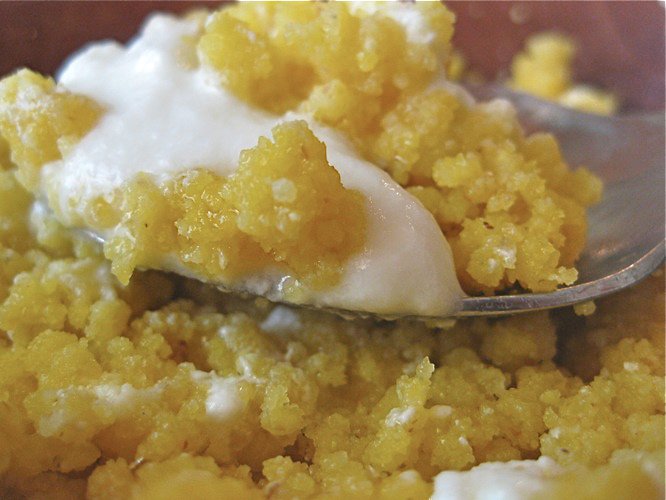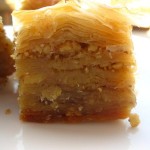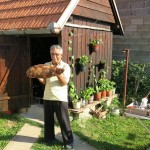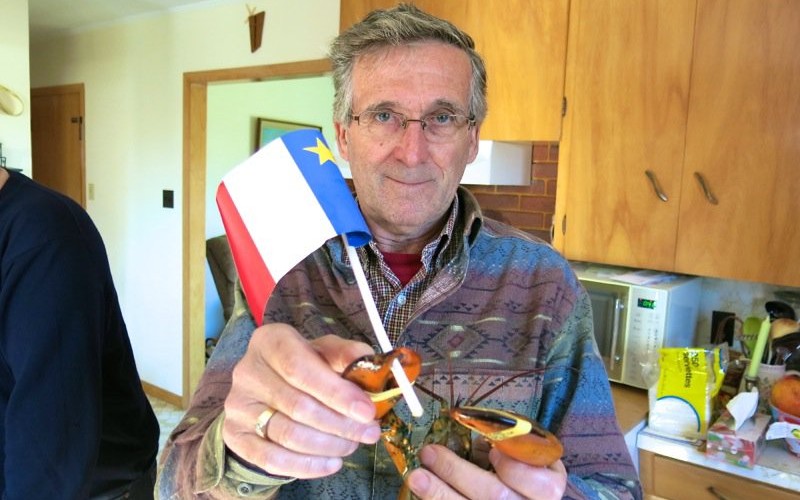Pura from the Kupres Area in Bosna
On the way to Kupresko Polje, we stopped for a cold drink at a hotel in the town of Kupres that Vanja remembered from his childhood. We sat for a moment, then he looked at me and asked, “œDo you remember the traditional pura that V.J. was telling us about? They serve it here. Do you want to try it?” Try it? What kind of a question is that for “œThe Canadian Foodie”? Of course I want to try a traditional food! Bring it on! I always promise a small taste, and regret forever not knowing about something when I am right there. I was so happy he remembered! Petar was also excited, as he had been brought up on pura and loved it. So, we ordered two after Vanja checked to see if it was still served in the traditional wooden bowls in the traditional manner. Yes. Pura is cornmeal cooked until all of the moisture is cooked out of it and it is crumbly and soft, yet very dry, and it is served with kiselo mleko (sour milk). Each came in its own traditional wooden container.
The cornmeal was exceptionally flavourful. It was very fresh and robust. The sour milk tasted to me very much like pavlaka (sour cream), but not as thick. Maybe my taste buds just have not matured, but I have no other frame of reference than the food from home I am familiar with.
In the Balkans, so far, I have discovered pavlaka (sour cream), kiselo mleko (sour milk which I believe is the yogurt we are familiar with in Canada), kajmak (the top layer of cooked milk after it cools off) which is a cross between heavy cream and butter in flavour, at times. Other times, kajmak is extremely sharp, and sour. The flavour depends upon the region, the animal, and the milk. It is served like a cheese, or a spread, or a salad. Mladi sir (young, unripened cheese) is everywhere: salted or unsalted. Unsalted is best, and you must try it before you buy it. The sellers are proud of their product and happy to have you taste. They are also very generous with their tasting portions, and will most likely open a package prepared for sale and cut off a big bite with their bare hands and a rustic knife for you with the warmest smile. I love the cow mladi sir from some vendors. It has to be fresh. There is nothing like it in Canada that I have found. The odd thing is, I have never found heavy cream, or whipping cream, in a store or anywhere. The people use something called slag which is similar to Cool Whip at home, and made completely from oil. With all of the specialized milk products available, I am so surprised not to find this. All rural country folk know how to make all kinds of cheeses, kajmak, and smoked meats. Every region has a different traditional way of making their cheeses and meats, and everyone in every region knows about the reputation or the specialties in the other regions. Thus, the pura.
This pura would be impossible to eat without the sour milk which as thick like our sour cream, but not as thick as their pavlaka. It definitely needed salt, and was a massive portion, but very delicious and satisfying.
So, an intimate memory of Kupres was had on the Flats, and in the small town. What really drove home the significance of this experience was visiting Sirogojno: the museum under the open sky. This is a reproduction of an ethnic Serbian Village from the 19th Century and the walk through there with Pava and Petar, and their explanations and memories brought this “œtraditional meal” forward into their early life time.
My pura experience was a literal “œtaste” of the past, for me. Incredible.



















Leave a Reply